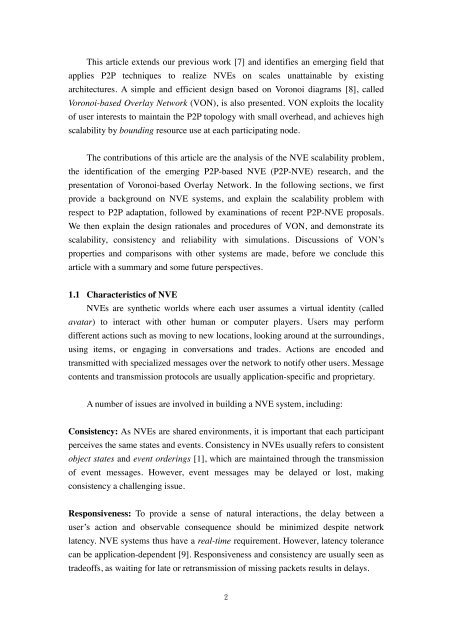A Scalable Peer-to-Peer Network for Virtual Environments - Evernote
A Scalable Peer-to-Peer Network for Virtual Environments - Evernote
A Scalable Peer-to-Peer Network for Virtual Environments - Evernote
You also want an ePaper? Increase the reach of your titles
YUMPU automatically turns print PDFs into web optimized ePapers that Google loves.
This article extends our previous work [7] and identifies an emerging field that<br />
applies P2P techniques <strong>to</strong> realize NVEs on scales unattainable by existing<br />
architectures. A simple and efficient design based on Voronoi diagrams [8], called<br />
Voronoi-based Overlay <strong>Network</strong> (VON), is also presented. VON exploits the locality<br />
of user interests <strong>to</strong> maintain the P2P <strong>to</strong>pology with small overhead, and achieves high<br />
scalability by bounding resource use at each participating node.<br />
The contributions of this article are the analysis of the NVE scalability problem,<br />
the identification of the emerging P2P-based NVE (P2P-NVE) research, and the<br />
presentation of Voronoi-based Overlay <strong>Network</strong>. In the following sections, we first<br />
provide a background on NVE systems, and explain the scalability problem with<br />
respect <strong>to</strong> P2P adaptation, followed by examinations of recent P2P-NVE proposals.<br />
We then explain the design rationales and procedures of VON, and demonstrate its<br />
scalability, consistency and reliability with simulations. ,-*./**-%0*+ %1+ 234)*+<br />
properties and comparisons with other systems are made, be<strong>for</strong>e we conclude this<br />
article with a summary and some future perspectives.<br />
1.1 Characteristics of NVE<br />
NVEs are synthetic worlds where each user assumes a virtual identity (called<br />
avatar) <strong>to</strong> interact with other human or computer players. Users may per<strong>for</strong>m<br />
different actions such as moving <strong>to</strong> new locations, looking around at the surroundings,<br />
using items, or engaging in conversations and trades. Actions are encoded and<br />
transmitted with specialized messages over the network <strong>to</strong> notify other users. Message<br />
contents and transmission pro<strong>to</strong>cols are usually application-specific and proprietary.<br />
A number of issues are involved in building a NVE system, including:<br />
Consistency: As NVEs are shared environments, it is important that each participant<br />
perceives the same states and events. Consistency in NVEs usually refers <strong>to</strong> consistent<br />
object states and event orderings [1], which are maintained through the transmission<br />
of event messages. However, event messages may be delayed or lost, making<br />
consistency a challenging issue.<br />
Responsiveness: To provide a sense of natural interactions, the delay between a<br />
user)* action and observable consequence should be minimized despite network<br />
latency. NVE systems thus have a real-time requirement. However, latency <strong>to</strong>lerance<br />
can be application-dependent [9]. Responsiveness and consistency are usually seen as<br />
tradeoffs, as waiting <strong>for</strong> late or retransmission of missing packets results in delays.<br />
"
















